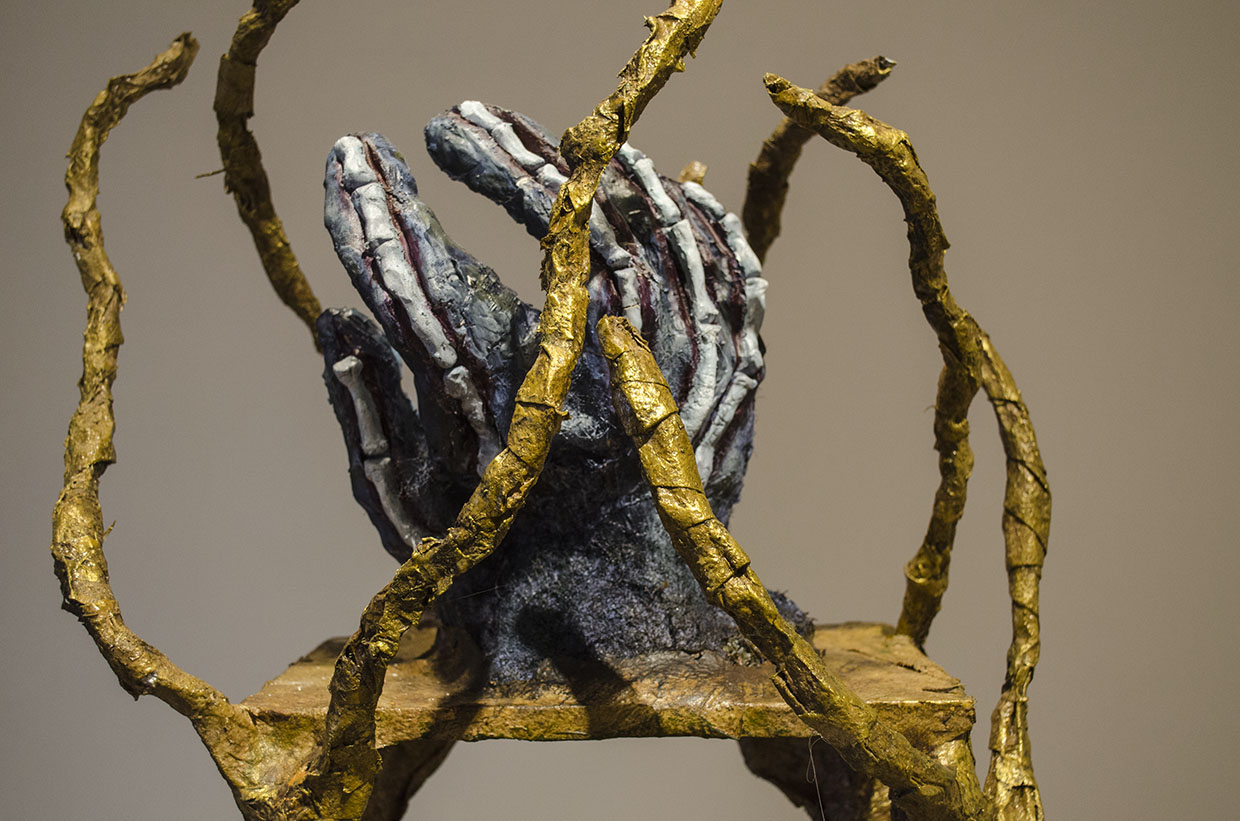About Emily
Baltimore City

Emily Tucci is a material-based sculptor focusing on issues of wildlife conservation and animal rights. She was born in Pennsylvania in 1994, and resides rural Chester County surrounded by farmland. She received her BFA in Fine Art and honors BA in Art History from University of Delaware in 2017. She moved to Baltimore and received her Post Baccalaureate in Fine Art Certificate from Maryland Institute College of Art in 2018, and is currently a graduate student there in the Rinehart School… more
Jump to a project:
Impala Trophy
Hunters display the animals they kill as a form of home decor, thus creating a trophy out of a once living creature. I have created a series of "trophies" that show how ingrained all elements of the creature are with each other with a focus on their anatomy. Elements of their natural environment are present within the piece, thus showing the integration of the animal within nature.
This piece represents the hunting of the African Impala for use of their horns.
-
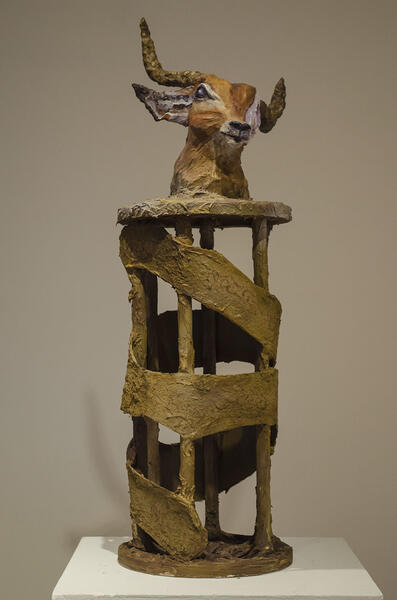 Impala TrophyHunters display the animals they kill as a form of home decor, thus creating a trophy out of a once living creature. I have created a series of "trophies" that show how ingrained all elements of the creature are with each other with a focus on their anatomy. Elements of their natural environment are present within the piece, thus showing the integration of the animal within nature. This piece represents the hunting of the African Impala for use of their horns. Wood, joint compound, clay, hand made paper made with dead leaves, acrylic, spray paint
Impala TrophyHunters display the animals they kill as a form of home decor, thus creating a trophy out of a once living creature. I have created a series of "trophies" that show how ingrained all elements of the creature are with each other with a focus on their anatomy. Elements of their natural environment are present within the piece, thus showing the integration of the animal within nature. This piece represents the hunting of the African Impala for use of their horns. Wood, joint compound, clay, hand made paper made with dead leaves, acrylic, spray paint -
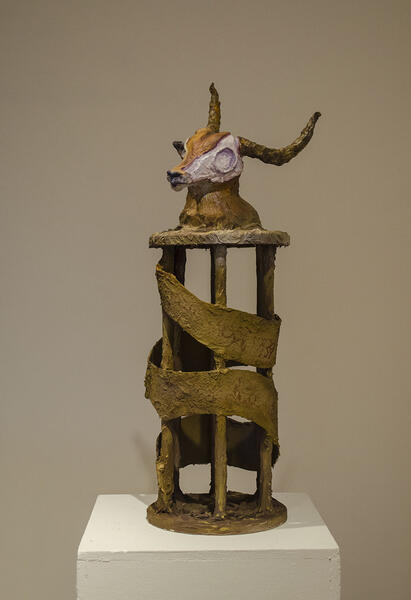 Impala Trophy (Detail)Hunters display the animals they kill as a form of home decor, thus creating a trophy out of a once living creature. I have created a series of "trophies" that show how ingrained all elements of the creature are with each other with a focus on their anatomy. Elements of their natural environment are present within the piece, thus showing the integration of the animal within nature. This piece represents the hunting of the African Impala for use of their horns.
Impala Trophy (Detail)Hunters display the animals they kill as a form of home decor, thus creating a trophy out of a once living creature. I have created a series of "trophies" that show how ingrained all elements of the creature are with each other with a focus on their anatomy. Elements of their natural environment are present within the piece, thus showing the integration of the animal within nature. This piece represents the hunting of the African Impala for use of their horns. -
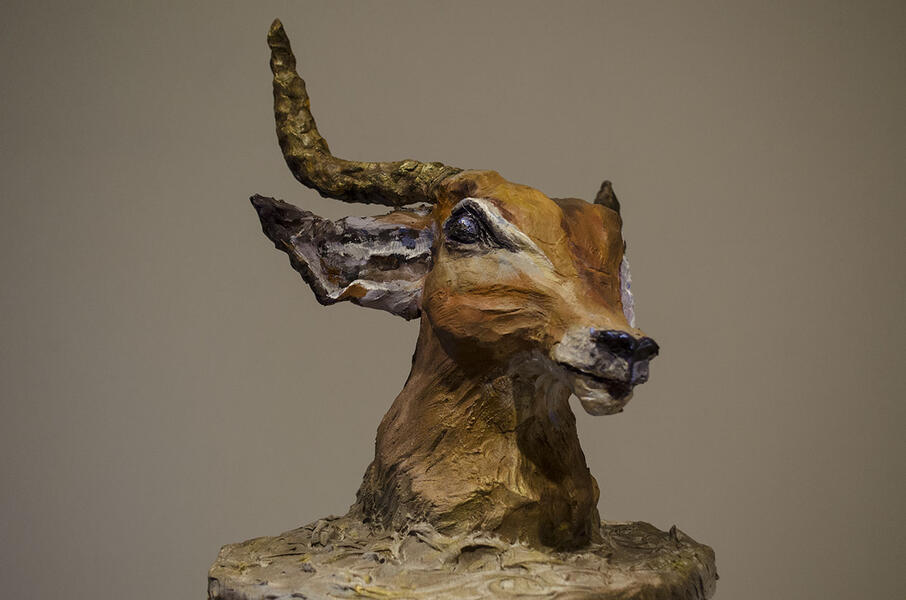 Impala Trophy (Detail)Hunters display the animals they kill as a form of home decor, thus creating a trophy out of a once living creature. I have created a series of "trophies" that show how ingrained all elements of the creature are with each other with a focus on their anatomy. Elements of their natural environment are present within the piece, thus showing the integration of the animal within nature. This piece represents the hunting of the African Impala for use of their horns.
Impala Trophy (Detail)Hunters display the animals they kill as a form of home decor, thus creating a trophy out of a once living creature. I have created a series of "trophies" that show how ingrained all elements of the creature are with each other with a focus on their anatomy. Elements of their natural environment are present within the piece, thus showing the integration of the animal within nature. This piece represents the hunting of the African Impala for use of their horns. -
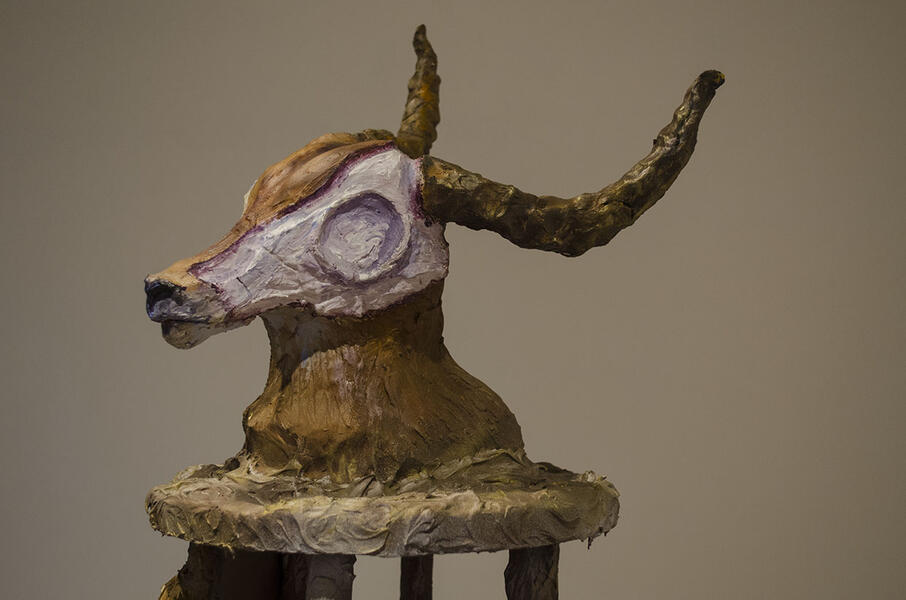 Impala Trophy (Detail)Hunters display the animals they kill as a form of home decor, thus creating a trophy out of a once living creature. I have created a series of "trophies" that show how ingrained all elements of the creature are with each other with a focus on their anatomy. Elements of their natural environment are present within the piece, thus showing the integration of the animal within nature. This piece represents the hunting of the African Impala for use of their horns.
Impala Trophy (Detail)Hunters display the animals they kill as a form of home decor, thus creating a trophy out of a once living creature. I have created a series of "trophies" that show how ingrained all elements of the creature are with each other with a focus on their anatomy. Elements of their natural environment are present within the piece, thus showing the integration of the animal within nature. This piece represents the hunting of the African Impala for use of their horns. -
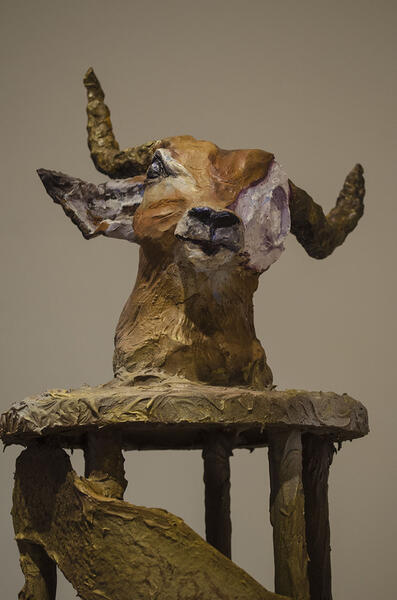 Impala Trophy (Detail)Hunters display the animals they kill as a form of home decor, thus creating a trophy out of a once living creature. I have created a series of "trophies" that show how ingrained all elements of the creature are with each other with a focus on their anatomy. Elements of their natural environment are present within the piece, thus showing the integration of the animal within nature. This piece represents the hunting of the African Impala for use of their horns.
Impala Trophy (Detail)Hunters display the animals they kill as a form of home decor, thus creating a trophy out of a once living creature. I have created a series of "trophies" that show how ingrained all elements of the creature are with each other with a focus on their anatomy. Elements of their natural environment are present within the piece, thus showing the integration of the animal within nature. This piece represents the hunting of the African Impala for use of their horns. -
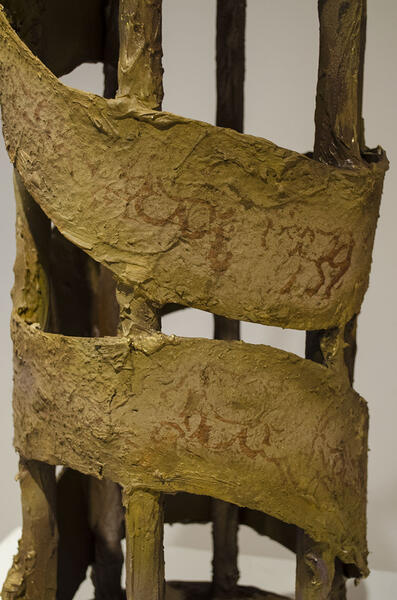 Impala Trophy (Detail)Hunters display the animals they kill as a form of home decor, thus creating a trophy out of a once living creature. I have created a series of "trophies" that show how ingrained all elements of the creature are with each other with a focus on their anatomy. Elements of their natural environment are present within the piece, thus showing the integration of the animal within nature. This piece represents the hunting of the African Impala for use of their horns.
Impala Trophy (Detail)Hunters display the animals they kill as a form of home decor, thus creating a trophy out of a once living creature. I have created a series of "trophies" that show how ingrained all elements of the creature are with each other with a focus on their anatomy. Elements of their natural environment are present within the piece, thus showing the integration of the animal within nature. This piece represents the hunting of the African Impala for use of their horns.
Gorilla Trophy
Hunters display the animals they kill as a form of home decor, thus creating a trophy out of a once living creature. I have created a series of "trophies" that show how ingrained all elements of the creature are with each other with a focus on their anatomy. Elements of their natural environment are present within the piece, thus showing the integration of the animal within nature.
This piece represents the hunting of gorillas for use of their hands, which some cultures falsely believe contain medicinal properties.
-
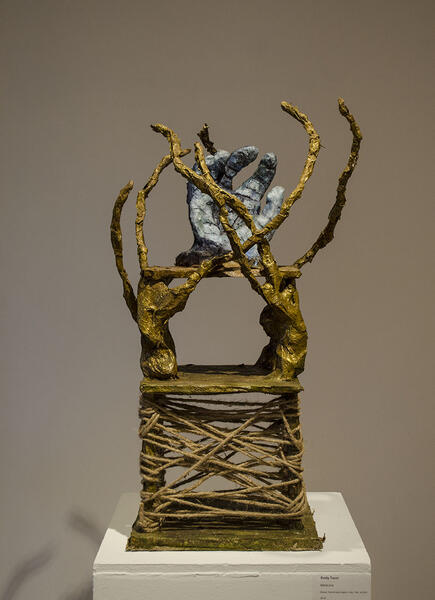 Gorilla TrophyHunters display the animals they kill as a form of home decor, thus creating a trophy out of a once living creature. I have created a series of "trophies" that show how ingrained all elements of the creature are with each other with a focus on their anatomy. Elements of their natural environment are present within the piece, thus showing the integration of the animal within nature. This piece represents the hunting of gorillas for use of their hands, which some cultures falsely believe contain medicinal properties. Wood, hand made paper made with dead leaves, clay, hair, spray paint, acrylic, hemp
Gorilla TrophyHunters display the animals they kill as a form of home decor, thus creating a trophy out of a once living creature. I have created a series of "trophies" that show how ingrained all elements of the creature are with each other with a focus on their anatomy. Elements of their natural environment are present within the piece, thus showing the integration of the animal within nature. This piece represents the hunting of gorillas for use of their hands, which some cultures falsely believe contain medicinal properties. Wood, hand made paper made with dead leaves, clay, hair, spray paint, acrylic, hemp -
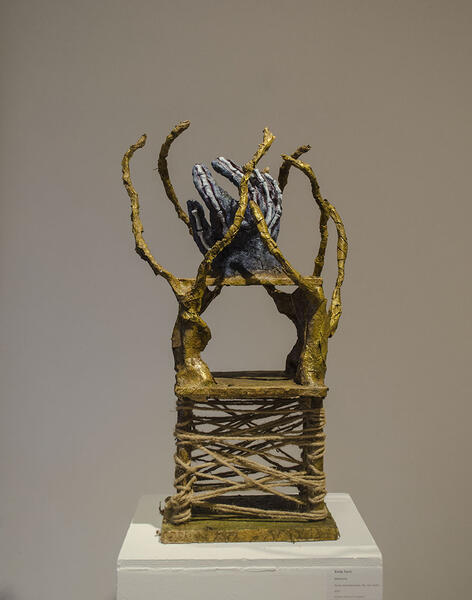 Gorilla Trophy (Detail)Hunters display the animals they kill as a form of home decor, thus creating a trophy out of a once living creature. I have created a series of "trophies" that show how ingrained all elements of the creature are with each other with a focus on their anatomy. Elements of their natural environment are present within the piece, thus showing the integration of the animal within nature. This piece represents the hunting of gorillas for use of their hands, which some cultures falsely believe contain medicinal properties.
Gorilla Trophy (Detail)Hunters display the animals they kill as a form of home decor, thus creating a trophy out of a once living creature. I have created a series of "trophies" that show how ingrained all elements of the creature are with each other with a focus on their anatomy. Elements of their natural environment are present within the piece, thus showing the integration of the animal within nature. This piece represents the hunting of gorillas for use of their hands, which some cultures falsely believe contain medicinal properties. -
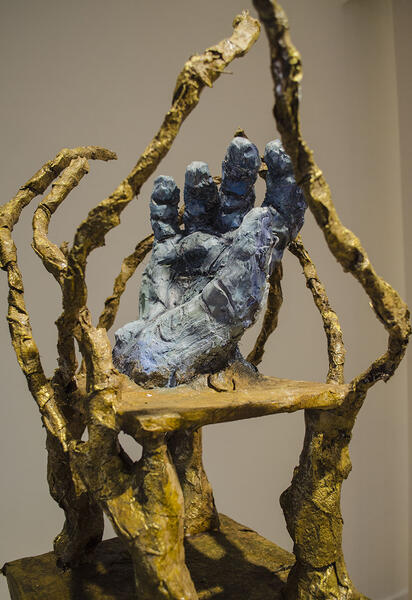 Gorilla Trophy (Detail)Hunters display the animals they kill as a form of home decor, thus creating a trophy out of a once living creature. I have created a series of "trophies" that show how ingrained all elements of the creature are with each other with a focus on their anatomy. Elements of their natural environment are present within the piece, thus showing the integration of the animal within nature. This piece represents the hunting of gorillas for use of their hands, which some cultures falsely believe contain medicinal properties.
Gorilla Trophy (Detail)Hunters display the animals they kill as a form of home decor, thus creating a trophy out of a once living creature. I have created a series of "trophies" that show how ingrained all elements of the creature are with each other with a focus on their anatomy. Elements of their natural environment are present within the piece, thus showing the integration of the animal within nature. This piece represents the hunting of gorillas for use of their hands, which some cultures falsely believe contain medicinal properties. -
 Gorilla Trophy (Detail)Hunters display the animals they kill as a form of home decor, thus creating a trophy out of a once living creature. I have created a series of "trophies" that show how ingrained all elements of the creature are with each other with a focus on their anatomy. Elements of their natural environment are present within the piece, thus showing the integration of the animal within nature. This piece represents the hunting of gorillas for use of their hands, which some cultures falsely believe contain medicinal properties.
Gorilla Trophy (Detail)Hunters display the animals they kill as a form of home decor, thus creating a trophy out of a once living creature. I have created a series of "trophies" that show how ingrained all elements of the creature are with each other with a focus on their anatomy. Elements of their natural environment are present within the piece, thus showing the integration of the animal within nature. This piece represents the hunting of gorillas for use of their hands, which some cultures falsely believe contain medicinal properties. -
 Gorilla Trophy 8.jpgHunters display the animals they kill as a form of home decor, thus creating a trophy out of a once living creature. I have created a series of "trophies" that show how ingrained all elements of the creature are with each other with a focus on their anatomy. Elements of their natural environment are present within the piece, thus showing the integration of the animal within nature. This piece represents the hunting of gorillas for use of their hands, which some cultures falsely believe contain medicinal properties.
Gorilla Trophy 8.jpgHunters display the animals they kill as a form of home decor, thus creating a trophy out of a once living creature. I have created a series of "trophies" that show how ingrained all elements of the creature are with each other with a focus on their anatomy. Elements of their natural environment are present within the piece, thus showing the integration of the animal within nature. This piece represents the hunting of gorillas for use of their hands, which some cultures falsely believe contain medicinal properties.
Horns
Hunters display the animals they kill as a form of home decor, thus creating a trophy out of a once living creature. I have created a series of "trophies" that show how ingrained all elements of the creature are with each other with a focus on their anatomy. Elements of their natural environment are present within the piece, thus showing the integration of the animal within nature.
This piece represents the hunting of impalas and antelope for their horns, which are often mounted and displayed.
-
 HornsHunters display the animals they kill as a form of home decor, thus creating a trophy out of a once living creature. I have created a series of "trophies" that show how ingrained all elements of the creature are with each other with a focus on their anatomy. Elements of their natural environment are present within the piece, thus showing the integration of the animal within nature. This piece represents the hunting of impalas and antelope for their horns, which are often mounted and displayed. Wood, joint compound, clay, spray paint, acrylic
HornsHunters display the animals they kill as a form of home decor, thus creating a trophy out of a once living creature. I have created a series of "trophies" that show how ingrained all elements of the creature are with each other with a focus on their anatomy. Elements of their natural environment are present within the piece, thus showing the integration of the animal within nature. This piece represents the hunting of impalas and antelope for their horns, which are often mounted and displayed. Wood, joint compound, clay, spray paint, acrylic -
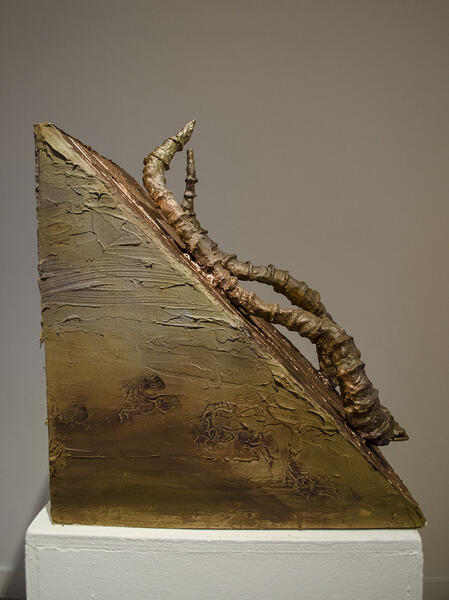 Horns (Detail)Hunters display the animals they kill as a form of home decor, thus creating a trophy out of a once living creature. I have created a series of "trophies" that show how ingrained all elements of the creature are with each other with a focus on their anatomy. Elements of their natural environment are present within the piece, thus showing the integration of the animal within nature. This piece represents the hunting of impalas and antelope for their horns, which are often mounted and displayed.
Horns (Detail)Hunters display the animals they kill as a form of home decor, thus creating a trophy out of a once living creature. I have created a series of "trophies" that show how ingrained all elements of the creature are with each other with a focus on their anatomy. Elements of their natural environment are present within the piece, thus showing the integration of the animal within nature. This piece represents the hunting of impalas and antelope for their horns, which are often mounted and displayed. -
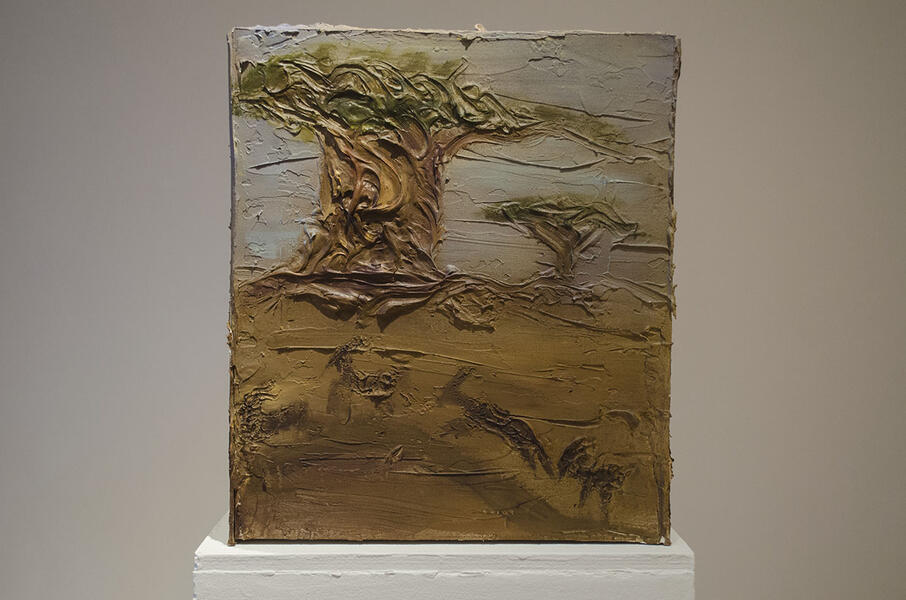 Horns (Detail)Hunters display the animals they kill as a form of home decor, thus creating a trophy out of a once living creature. I have created a series of "trophies" that show how ingrained all elements of the creature are with each other with a focus on their anatomy. Elements of their natural environment are present within the piece, thus showing the integration of the animal within nature. This piece represents the hunting of impalas and antelope for their horns, which are often mounted and displayed.
Horns (Detail)Hunters display the animals they kill as a form of home decor, thus creating a trophy out of a once living creature. I have created a series of "trophies" that show how ingrained all elements of the creature are with each other with a focus on their anatomy. Elements of their natural environment are present within the piece, thus showing the integration of the animal within nature. This piece represents the hunting of impalas and antelope for their horns, which are often mounted and displayed.
Elephant Trophy
Hunters display the animals they kill as a form of home decor, thus creating a trophy out of a once living creature. I have created a series of "trophies" that show how ingrained all elements of the creature are with each other with a focus on their anatomy. Elements of their natural environment are present within the piece, thus showing the integration of the animal within nature.
This piece represents the hunting of elephants for their tusks.
-
 Elephant TrophyHunters display the animals they kill as a form of home decor, thus creating a trophy out of a once living creature. I have created a series of "trophies" that show how ingrained all elements of the creature are with each other with a focus on their anatomy. Elements of their natural environment are present within the piece, thus showing the integration of the animal within nature. This piece represents the hunting of elephants for their tusks. Wood, sand clay, plexi glass, clay, acrylic, sand
Elephant TrophyHunters display the animals they kill as a form of home decor, thus creating a trophy out of a once living creature. I have created a series of "trophies" that show how ingrained all elements of the creature are with each other with a focus on their anatomy. Elements of their natural environment are present within the piece, thus showing the integration of the animal within nature. This piece represents the hunting of elephants for their tusks. Wood, sand clay, plexi glass, clay, acrylic, sand -
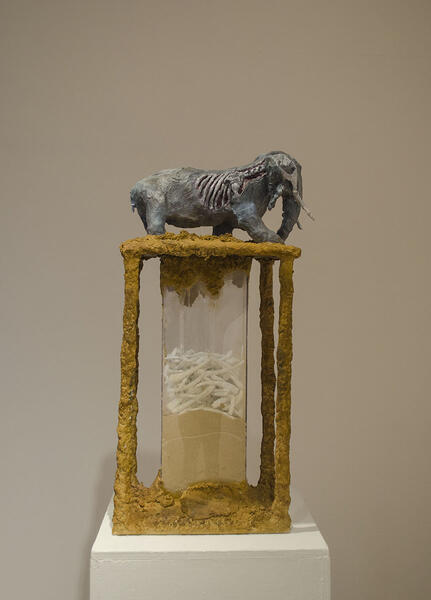 Elephant Trophy (Detail)Hunters display the animals they kill as a form of home decor, thus creating a trophy out of a once living creature. I have created a series of "trophies" that show how ingrained all elements of the creature are with each other with a focus on their anatomy. Elements of their natural environment are present within the piece, thus showing the integration of the animal within nature. This piece represents the hunting of elephants for their tusks.
Elephant Trophy (Detail)Hunters display the animals they kill as a form of home decor, thus creating a trophy out of a once living creature. I have created a series of "trophies" that show how ingrained all elements of the creature are with each other with a focus on their anatomy. Elements of their natural environment are present within the piece, thus showing the integration of the animal within nature. This piece represents the hunting of elephants for their tusks. -
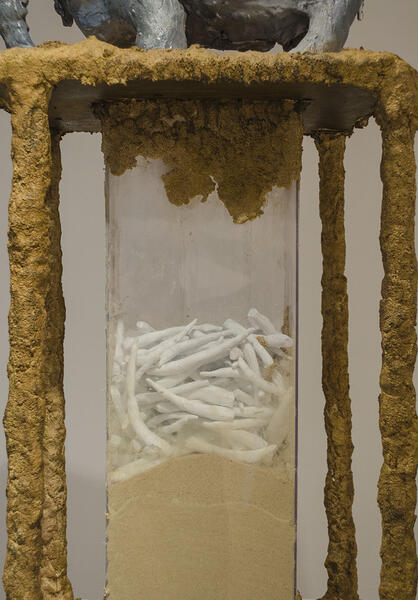 Elephant Trophy (Detail)Hunters display the animals they kill as a form of home decor, thus creating a trophy out of a once living creature. I have created a series of "trophies" that show how ingrained all elements of the creature are with each other with a focus on their anatomy. Elements of their natural environment are present within the piece, thus showing the integration of the animal within nature. This piece represents the hunting of elephants for their tusks.
Elephant Trophy (Detail)Hunters display the animals they kill as a form of home decor, thus creating a trophy out of a once living creature. I have created a series of "trophies" that show how ingrained all elements of the creature are with each other with a focus on their anatomy. Elements of their natural environment are present within the piece, thus showing the integration of the animal within nature. This piece represents the hunting of elephants for their tusks. -
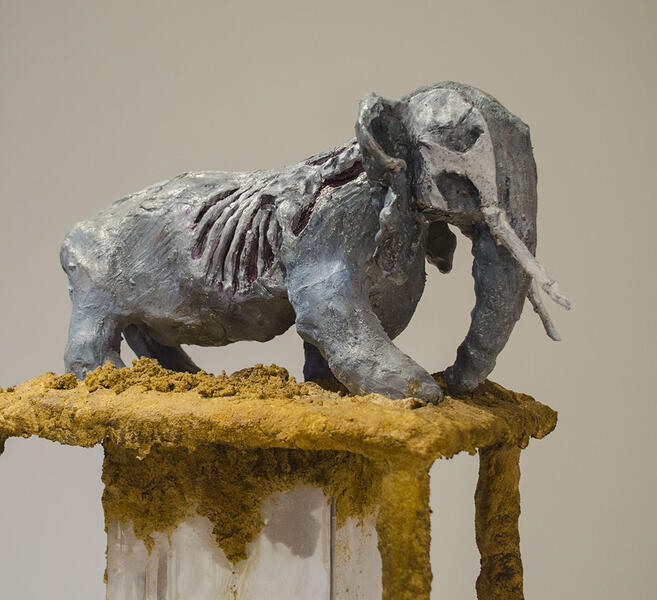 Elephant Trophy (Detail)Hunters display the animals they kill as a form of home decor, thus creating a trophy out of a once living creature. I have created a series of "trophies" that show how ingrained all elements of the creature are with each other with a focus on their anatomy. Elements of their natural environment are present within the piece, thus showing the integration of the animal within nature. This piece represents the hunting of elephants for their tusks.
Elephant Trophy (Detail)Hunters display the animals they kill as a form of home decor, thus creating a trophy out of a once living creature. I have created a series of "trophies" that show how ingrained all elements of the creature are with each other with a focus on their anatomy. Elements of their natural environment are present within the piece, thus showing the integration of the animal within nature. This piece represents the hunting of elephants for their tusks.
Reduced
Elephants are valued most for their ivory tusks. The complexity and variation of this creature is overlooked and reduced to simply the value of these tusks. This piece is a reflection of this reduction, with the tusks beginning to vanish in their translucent state. They are both incredibly present, yet missing.
Wood, joint compound, tape, spray paint
Wood, joint compound, tape, spray paint
-
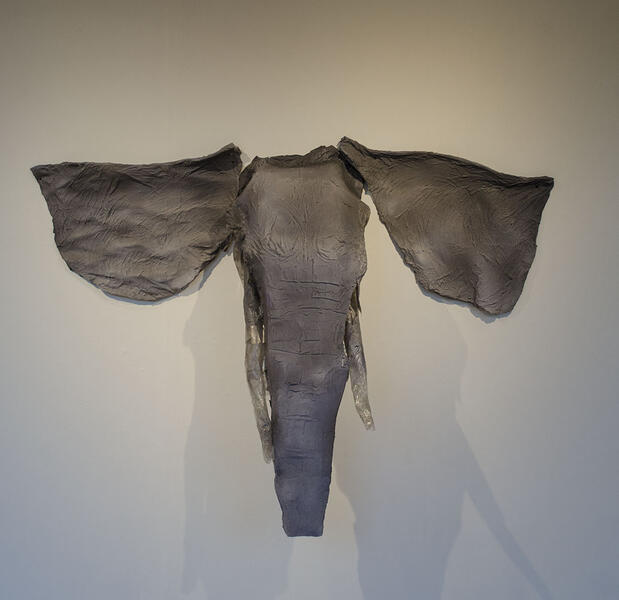 ReducedElephants are valued most for their ivory tusks. The complexity and variation of this creature is overlooked and reduced to simply the value of these tusks. This piece is a reflection of this reduction, with the tusks beginning to vanish in their translucent state. They are both incredibly present, yet missing.
ReducedElephants are valued most for their ivory tusks. The complexity and variation of this creature is overlooked and reduced to simply the value of these tusks. This piece is a reflection of this reduction, with the tusks beginning to vanish in their translucent state. They are both incredibly present, yet missing. -
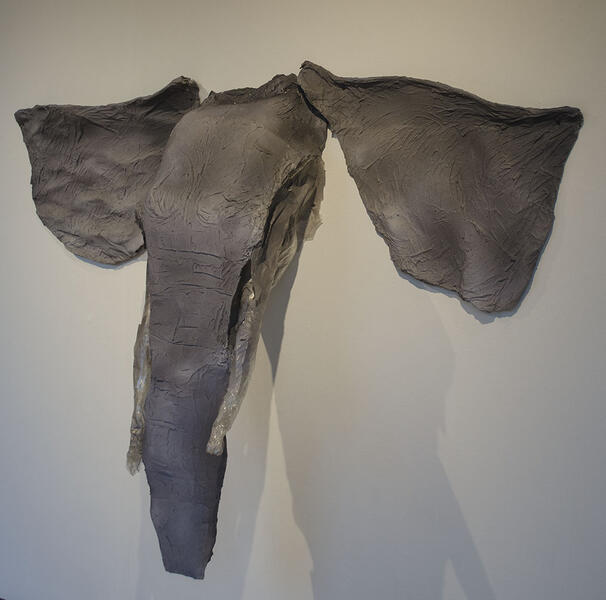 Reduced (Detail)Detail of Reduced: Elephants are valued most for their ivory tusks. The complexity and variation of this creature is overlooked and reduced to simply the value of these tusks. This piece is a reflection of this reduction, with the tusks beginning to vanish in their translucent state. They are both incredibly present, yet missing.
Reduced (Detail)Detail of Reduced: Elephants are valued most for their ivory tusks. The complexity and variation of this creature is overlooked and reduced to simply the value of these tusks. This piece is a reflection of this reduction, with the tusks beginning to vanish in their translucent state. They are both incredibly present, yet missing.









